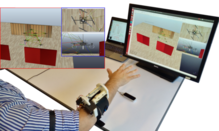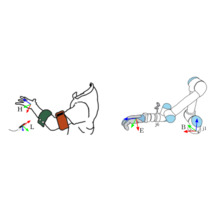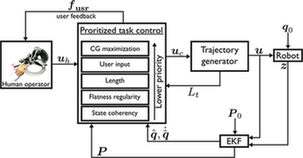This paper presents a wearable haptic device for the forearm and its application in robotic teleoperation. The device is able to provide skin stretch, pressure, and vibrotactile stimuli. Two servo motors, housed in a 3D printed lightweight platform, actuate an elastic fabric belt, wrapped around the arm. When the two servo motors rotate in opposite directions, the belt is tightened (or loosened), thereby compressing (or decompressing) the arm. On the other hand, when the two motors rotate in the same direction, the belt applies a shear force to the arm skin. Moreover, the belt houses four vibrotactile motors, positioned evenly around the arm at 90 degrees from each other. The device weights 220 g for 115×122×50 mm of dimensions, making it wearable and unobtrusive. We carried out a perceptual characterization of the device as well as two human-subjects teleoperation experiments in a virtual environment, employing a total of 34 subjects. In the first experiment, participants were asked to control the motion of a robotic manipulator for grasping an object; in the second experiment, participants were asked to teleoperate the motion of a quadrotor fleet along a given path. In both scenarios, the wearable haptic device provided feedback information about the status of the slave robot(s) and of the given task. Results showed the effectiveness of the proposed device. Performance on completion time, length trajectory, and perceived effectiveness when using the wearable device improved of 19.8%, 25.1%, and 149.1% than when wearing no device, respectively. Finally, all subjects but three preferred the conditions including wearable haptics.
@article{aggravi2018design,
Title = {{Design and evaluation of a wearable haptic device for skin stretch, pressure, and vibrotactile stimuli}},
Author = {Aggravi, Marco and Paus{\'e}, Florent and Giordano, Paolo Robuffo and Pacchierotti, Claudio},
Journal = {{IEEE Robotics and Automation Letters}},
Volume = {3},
Number = {3},
Pages = {2166--2173},
Year = {2018},
Publisher = {{IEEE}},
DOI = {10.1109/LRA.2018.2810887}
}


